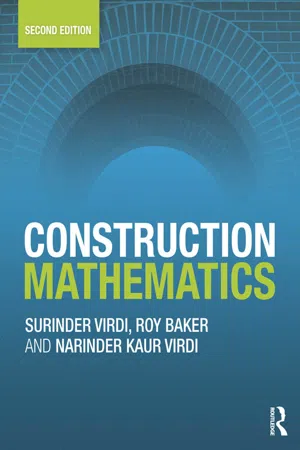
Construction Mathematics
- 336 pages
- English
- ePUB (mobile friendly)
- Available on iOS & Android
Construction Mathematics
About this book
Construction Mathematics is an introductory level mathematics text, written specifically for students of construction and related disciplines.
- Learn by tackling exercises based on real-life construction maths. Examples include: costing calculations, labour costs, cost of materials and setting out of building components.
- Suitable for beginners and easy to follow throughout.
- Learn the essential basic theory along with the practical necessities.
The second edition of this popular textbook is fully updated to match new curricula, and expanded to include even more learning exercises. End of chapter exercises cover a range of theoretical as well as practical problems commonly found in construction practice, and three detailed assignments based on practical tasks give students the opportunity to apply all the knowledge they have gained.
Construction Mathematics addresses all the mathematical requirements of Level 2 construction NVQs from City & Guilds/CITB and Edexcel courses, including the BTEC First Diploma in Construction. Additional coverage of the core unit Mathematics in Construction and the Built Environment from BTEC National Construction, Civil Engineering and Building Services courses makes this an essential revision aid for students who do not have Level 2 mathematics experience before commencing their BTEC National studies. This is also the ideal primer for any reader who wishes to refresh their mathematics knowledge before going into a construction HNC or BSc.
Frequently asked questions
- Essential is ideal for learners and professionals who enjoy exploring a wide range of subjects. Access the Essential Library with 800,000+ trusted titles and best-sellers across business, personal growth, and the humanities. Includes unlimited reading time and Standard Read Aloud voice.
- Complete: Perfect for advanced learners and researchers needing full, unrestricted access. Unlock 1.4M+ books across hundreds of subjects, including academic and specialized titles. The Complete Plan also includes advanced features like Premium Read Aloud and Research Assistant.
Please note we cannot support devices running on iOS 13 and Android 7 or earlier. Learn more about using the app.
Information
CHAPTER 1
Using a scientific calculator
1.1 Introduction
1.2 Keys of a scientific calculator
Table of contents
- Cover
- Half Title
- Title Page
- Copyright Page
- Table of Contents
- Preface to the second edition
- Preface to the first edition
- How to use this book
- Acknowledgements
- Abbreviations and units
- 1 Using a scientific calculator
- 2 Numbers
- 3 Basic algebra
- 4 Indices and logarithms
- 5 Standard form, significant figures and estimation
- 6 Transposition and evaluation of formulae
- 7 Fractions and percentages
- 8 Graphs
- 9 Units and their conversion
- 10 Geometry
- 11 Areas (1)
- 12 Volumes (1)
- 13 Trigonometry (1)
- 14 Setting out
- 15 Costing: materials and labour
- 16 Statistics
- 17 Areas and volumes (2)
- 18 Areas and volumes (3)
- 19 Trigonometry (2)
- 20 Computer techniques
- 21 Assignments
- Appendix 1: Concrete mix
- Appendix 2: Solutions
- Index